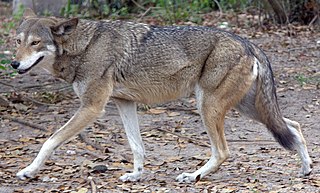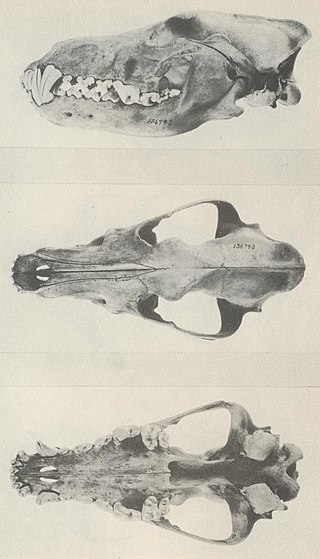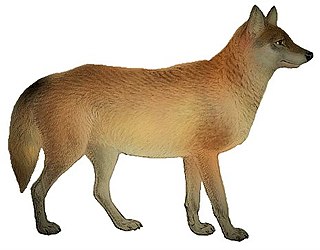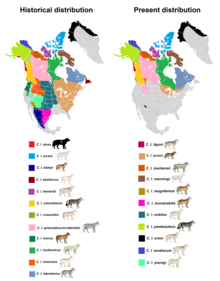
There are 38 subspecies of Canis lupus listed in the taxonomic authority Mammal Species of the World. These subspecies were named over the past 250 years, and since their naming, a number of them have gone extinct. The nominate subspecies is the Eurasian wolf.

The red wolf is a canine native to the southeastern United States. Its size is intermediate between the coyote and gray wolf.

The Hokkaido wolf, also known as the Ezo wolf and in Russia as the Sakhalin wolf, is an extinct subspecies of gray wolf that once inhabited coastal northeast Asia. Its nearest relatives were the wolves of North America rather than Asia. It was exterminated in Hokkaido during the Meiji Restoration period, when American-style agricultural reforms incorporated the use of strychnine-laced baits to kill livestock predators. Some taxonomists believe that it survived up until 1945 on the island of Sakhalin. It was one of two subspecies that were once found in the Japanese archipelago, the other being the Japanese wolf.

The Mexican wolf, also known as the lobo, is a subspecies of gray wolf native to southeastern Arizona and southern New Mexico in the United States, and northern Mexico. It once also ranged into western Texas. It is the smallest of North America's gray wolves, and is similar to the Great Plains wolf, though it is distinguished by its smaller, narrower skull and its darker pelt, which is yellowish-gray and heavily clouded with black over the back and tail. Its ancestors were likely the first gray wolves to enter North America after the extinction of the Beringian wolf, as indicated by its southern range and basal physical and genetic characteristics.

The northwestern wolf, also known as the Mackenzie Valley wolf, Alaskan timber wolf, or Canadian timber wolf, is a subspecies of gray wolf in western North America. Arguably the largest gray wolf subspecies in the world, it ranges from Alaska, the upper Mackenzie River Valley; southward throughout the western Canadian provinces, aside from prairie landscapes in its southern portions, as well as the Northwestern United States.

The Great Plains wolf, also known as the buffalo wolf or loafer, is a subspecies of gray wolf that once extended throughout the Great Plains, from southern Manitoba and Saskatchewan in Canada southward to northern Texas in the United States. The subspecies was thought to be extinct in 1926, until studies declared that its descendants were found in Minnesota, Wisconsin and Michigan. They were described as a large, light-colored wolf but with black and white varying between individual wolves, with some all white or all black. The Native Americans of North Dakota told of how only three Great Plains wolves could bring down any sized bison.

The Kenai Peninsula wolf, also known as the Kenai Peninsula grey wolf, is an extinct subspecies of the gray wolf that lived on the Kenai Peninsula in southern Alaska.

Bernard's wolf, also known as the Banks Island wolf or the Banks Island tundra wolf, is an extinct subspecies of the gray wolf that was limited to Banks and Victoria Island of the Arctic Archipelago.

The Cascade mountain wolf is an extinct subspecies of the gray wolf that was once found in the Pacific Northwest, but became extinct in 1940.
Gregory's wolf, also known as the Mississippi Valley wolf, was a subspecies of the red wolf. It was declared extinct in 1980. It once roamed the regions in and around the lower Mississippi River basin.

The Manitoba wolf, also known as the grey-white wolf, is an extinct subspecies of gray wolf that roamed in the southern Northwest Territories, northern Alberta, Saskatchewan, and south-central Manitoba. This wolf is recognized as a subspecies of Canis lupus in the taxonomic authority Mammal Species of the World (2005).

The Hudson Bay wolf is a subspecies of gray wolf native to the northern Kivalliq Region, including the northwestern coast of Hudson Bay in Canada. It was first classed as a distinct subspecies in 1941 by Edward Goldman, who described it as being a white colored, medium-sized subspecies similar to C. l. arctos, but with a flatter skull. This wolf is recognized as a subspecies of Canis lupus in the taxonomic authority Mammal Species of the World (2005).

The northern Rocky Mountain wolf, also known as the northern Rocky Mountain timber wolf, is a subspecies of gray wolf native to the northern Rocky Mountains. It is a light-colored, medium to large-sized subspecies with a narrow, flattened frontal bone. The subspecies was initially listed as Endangered on March 9, 1978, but had the classification removed in the year 2000 due to the effects of the Northern Rocky Mountain Wolf Recovery Plan. On August 6, 2010, the northern Rocky Mountain wolf was ordered to be returned under Endangered Species Act protections by U.S. District Judge Donald Molloy in a decision overturning a previous ruling by the U.S. Fish and Wildlife Service. They were later removed on August 31, 2012 from the list because of Idaho, Montana, and Wyoming meeting the population quotas for the species to be considered stable. This wolf is recognized as a subspecies of Canis lupus in the taxonomic authority Mammal Species of the World (2005).

The Labrador wolf is a subspecies of gray wolf native to Labrador and northern Quebec. It has been described as ranging in color from dark grizzly-gray to almost white, and of being closely related to the Newfoundland wolf. This wolf is recognized as a subspecies of Canis lupus in the taxonomic authority Mammal Species of the World (2005).

The Texas wolf is an extinct subspecies of gray wolf, distinct from the Texas red wolf, whose range once included southern and western Texas and northeastern Mexico.

The Alaskan tundra wolf, also known as the barren-ground wolf, is a North American subspecies of gray wolf native to the barren grounds of the Arctic coastal tundra region. It was named in 1912 by Gerrit Smith Miller Jr., who noted that it closely approaches the Great Plains wolf in skull and tooth morphology, though possessing a narrower rostrum and palate. It is a large, white-colored wolf closely resembling C. l. pambasileus, though lighter in color. This wolf is recognized as a subspecies of Canis lupus in the taxonomic authority Mammal Species of the World (2005).

The southern Rocky Mountain wolf is an extinct subspecies of gray wolf which was once distributed over southeastern Idaho, southwestern Wyoming, northeastern Nevada, Utah, western and central Colorado, northwestern Arizona, and northwestern New Mexico. It was a light-colored, medium-sized subspecies closely resembling the Great Plains wolf, though larger, with more blackish-buff hairs on the back. This wolf went extinct by 1935. Wolves of the subspecies Canis lupus occidentalis have now been reestablished in Idaho and Wyoming.

The Mongolian wolf is a subspecies of gray wolf which is native to Mongolia, northern and central China, Korea, and the Ussuri region of Russia.
The Dhole or mountain wolf is a canid species native to Asia.


















